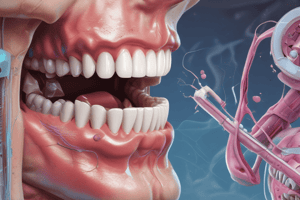Podcast
Questions and Answers
What is the cause of hairy tongue?
What is the cause of hairy tongue?
- Chlorhexidine mouthwash
- Tobacco use
- Chromogenic bacteria trapped within hyperplastic filiform papillae (correct)
- Accidental implantation of foreign material
Which factor is not related to oral candidosis?
Which factor is not related to oral candidosis?
- Chlorhexidine mouthwash
- Subgingival calculus
- Hairy tongue (correct)
- Tobacco use
What is the most common site for physiologic pigmentation?
What is the most common site for physiologic pigmentation?
- Attached gingiva (correct)
- Buccal mucosa
- Marginal gingiva
- Hard palate
What is the characteristic of physiologic pigmentation?
What is the characteristic of physiologic pigmentation?
What can cause post-inflammatory melanosis?
What can cause post-inflammatory melanosis?
Which of the following can cause hairy tongue?
Which of the following can cause hairy tongue?
What can cause post-inflammatory melanosis?
What can cause post-inflammatory melanosis?
Which factor is not related to oral candidosis?
Which factor is not related to oral candidosis?
What is the most common site for physiologic pigmentation?
What is the most common site for physiologic pigmentation?
Flashcards are hidden until you start studying
Study Notes
Oral Mucosal Pigmentations
- Oral mucosal pigmentations can be classified into three main categories: melanocytic, vascular, and exogenous.
Clinical Evaluation
- A pigmented area should be dry during evaluation.
- Digital palpation is used to assess changes in texture.
- The diascopy test (blanching) is used to aid in diagnosis.
- Pain assessment and clinical photographs are also part of the evaluation process.
- Biopsy is sometimes necessary for a definitive diagnosis.
Extrinsic Pigmentations
- Extrinsic pigmentations are superficial staining from pigments/dyes.
- Examples of extrinsic pigmentations include oral staining from food, beverage, or environmental factors.
Learning Objectives
- Recall the different types and features of melanocytic oral mucosal pigmentations.
- Recall vascular and systemic conditions that may result in oral mucosal pigmentations.
- Discuss the sources and features of exogenous pigmentations of the oral mucosa.
- Outline the malignant conditions that may present as oral mucosal pigmentations.
- Discuss the management of oral mucosal pigmentations where indicated.
Studying That Suits You
Use AI to generate personalized quizzes and flashcards to suit your learning preferences.



